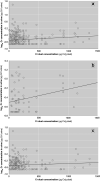Two decades of exposure assessment studies on chromate production waste in Jersey City, New Jersey--what we have learned about exposure characterization and its value to public health and remediation
- PMID: 23131713
- PMCID: PMC4286875
- DOI: 10.1038/jes.2012.100
Two decades of exposure assessment studies on chromate production waste in Jersey City, New Jersey--what we have learned about exposure characterization and its value to public health and remediation
Abstract
During much of the twentieth century, Jersey City, New Jersey was the leading center of chromate production in the United States. Chromate production produced huge volumes of chromium ore-processing residue containing many parts per million of hexavalent chromium. Starting in the 1990s, we undertook a series of studies to identify exposed populations, sources and pathways of exposure and the effectiveness of remediation activities in Jersey City. These studies revealed the effectiveness and success of the remediation activities. The sequence of studies presented here, builds on the lessons learned from each preceding study and illustrates how these studies advanced the field of exposure science in important ways, including the use of household dust as a measure of exposure to contaminants originating in the outdoor environment; development of effective and reproducible dust sampling; use of household dust to track temporal changes in exposure; understanding of the spatial relationship between sources of passive outdoor particulate emissions and residential exposure; use of focused biomonitoring to assess exposure under conditions of large inter-individual variability; and utility of linking environmental monitoring and biomonitoring. For chromium, the studies have demonstrated the use of Cr(+6)-specific analytical methods for measuring low concentrations of Cr(+6) in household dust and understanding of the occurrence of Cr(+6) in the background residential environment. We strongly recommend that environmental and public health agencies evaluate sites for their potential for off-site exposure and apply these tools in cases with significant potential as appropriate. This approach is especially important when contamination is widespread and/or a large population is potentially exposed. In such cases, these tools should be used to identify, characterize and then reduce the exposure to the off-site as well as on-site population. Importantly, these tools can be used in a demonstrable and quantifiable manner to provide both clarity and closure to concerned stakeholders.
Figures


Similar articles
-
A post-remediation assessment in Jersey City of the association of hexavalent chromium in house dust and urinary chromium in children.J Expo Sci Environ Epidemiol. 2015 Nov-Dec;25(6):616-22. doi: 10.1038/jes.2015.50. Epub 2015 Sep 2. J Expo Sci Environ Epidemiol. 2015. PMID: 26329141
-
Hexavalent chromium in house dust--a comparison between an area with historic contamination from chromate production and background locations.Sci Total Environ. 2010 Oct 1;408(21):4993-8. doi: 10.1016/j.scitotenv.2010.07.035. Epub 2010 Aug 9. Sci Total Environ. 2010. PMID: 20692023 Free PMC article.
-
The association of chromium in household dust with urinary chromium in residences adjacent to chromate production waste sites.Environ Health Perspect. 1998 Dec;106(12):833-9. doi: 10.1289/ehp.106-1533240. Environ Health Perspect. 1998. PMID: 9831544 Free PMC article.
-
Dioxin- and POP-contaminated sites--contemporary and future relevance and challenges: overview on background, aims and scope of the series.Environ Sci Pollut Res Int. 2008 Jul;15(5):363-93. doi: 10.1007/s11356-008-0024-1. Epub 2008 Jul 3. Environ Sci Pollut Res Int. 2008. PMID: 18597132 Review.
-
Sources, pathways, and relative risks of contaminants in surface water and groundwater: a perspective prepared for the Walkerton inquiry.J Toxicol Environ Health A. 2002 Jan 11;65(1):1-142. doi: 10.1080/152873902753338572. J Toxicol Environ Health A. 2002. PMID: 11809004 Review.
Cited by
-
Information needs, approaches, and case studies in human health risk communication.Risk Anal. 2022 Nov;42(11):2376-2399. doi: 10.1111/risa.14006. Epub 2022 Sep 13. Risk Anal. 2022. PMID: 36100396 Free PMC article.
-
A post-remediation assessment in Jersey City of the association of hexavalent chromium in house dust and urinary chromium in children.J Expo Sci Environ Epidemiol. 2015 Nov-Dec;25(6):616-22. doi: 10.1038/jes.2015.50. Epub 2015 Sep 2. J Expo Sci Environ Epidemiol. 2015. PMID: 26329141
References
-
- USEPA. Integrated Risk Information System (IRIS) 2010 accessed at: http://www.epa.gov/ncea/iris/subst/0144.htm11/4/2010.
-
- Stern AH. A quantitative assessment of the carcinogenicity of hexavalent chromium by the oral route and its relevance to human exposure. Environ Res. 2010;110:798–807. - PubMed
-
- Stern AH, Bagdon RE, Hazen RE, Marzulli FN. Risk assessment of the allergic dermatitis potential of environmental exposure to hexavalent chromium. J Toxicol Environ Health. 1993;40:613–641. - PubMed
Publication types
MeSH terms
Substances
Grants and funding
LinkOut - more resources
Full Text Sources

